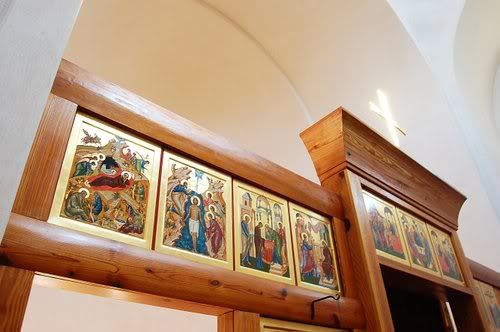


Holy Ascension is part of the Orthodox Church in America, which is aligned with Russian Orthodoxy. The church building is intimate and unusual, Shkolnik said.
Most new Orthodox churches in the U.S. share a problem: a lack of historical knowledge. But Holy Ascension marries beautiful aesthetics with pious tradition, he said. And it's built well. The painters will work with plaster walls, not drywall. This means they can use a long-lasting silicon paint developed in Germany in the 19th century.
Religious paintings in Western art are often compelling images that tell stories, express emotion or convey the significance of a particular figure. But icons are something else: They are objects of art imbued with the spirit of God and are meant to be venerated.
In Orthodox Christianity, icons are central to the worship experience. These images typically are painted on wood but are often made with ceramics, mosaic tiles, embroidery, metals or other materials. Meant to be an integrated part of religious rites, they describe Scriptures through images.
Icons are artful, but not merely art, historians and theologians are quick to point out. They are beautiful, but their beauty is less a result of the maker's skill than a consequence of the subject matter they symbolize: the holiness of the Virgin, the grace of Christ, the love of God. The images are thought to be sacred manifestations of the divine subjects they portray.
When objects depicting religious themes and figures are made thus holy, it is said that miracles can happen.
"Such elaborate decoration is a visual reminder to the worshiper not only of the beauty of God, but also that our earthly worship joins the eternal worship of God in heaven and we are 'surrounded by a great cloud of witnesses,' " Parker said, citing Hebrews 12:1.

The more things change, the more they stay the same. Or perhaps it's the other way around.
The altar at Holy Ascension already consists of a large wooden templon, or barrier, that separates the nave and altar. It is decorated with panels and columns portraying religious figures painted by Shkolnik.
Eventually, he and his team will paint the other walls and the dome of the little church, covering the interior with iconography. While the central image on the east wall will be Mary of the Sign, the west wall of most Orthodox churches typically has the Last Judgment and/or the dormition (death) of Mary, Parker said.
To the east is new life and the promise of everlasting salvation. To the west, the image "reminds us that all of us will die one day and stand before the judge," Parker said.


Комментариев нет:
Отправить комментарий